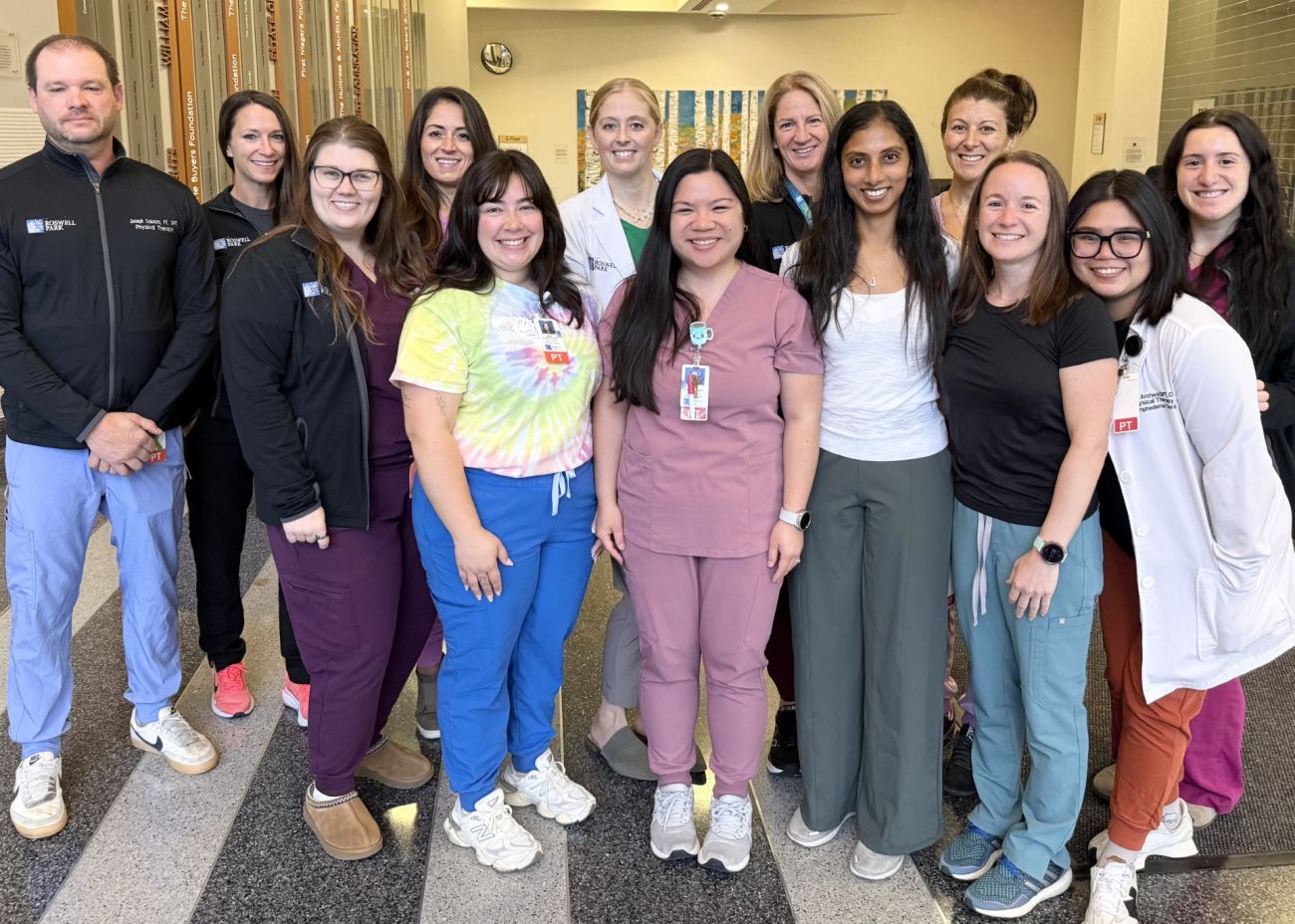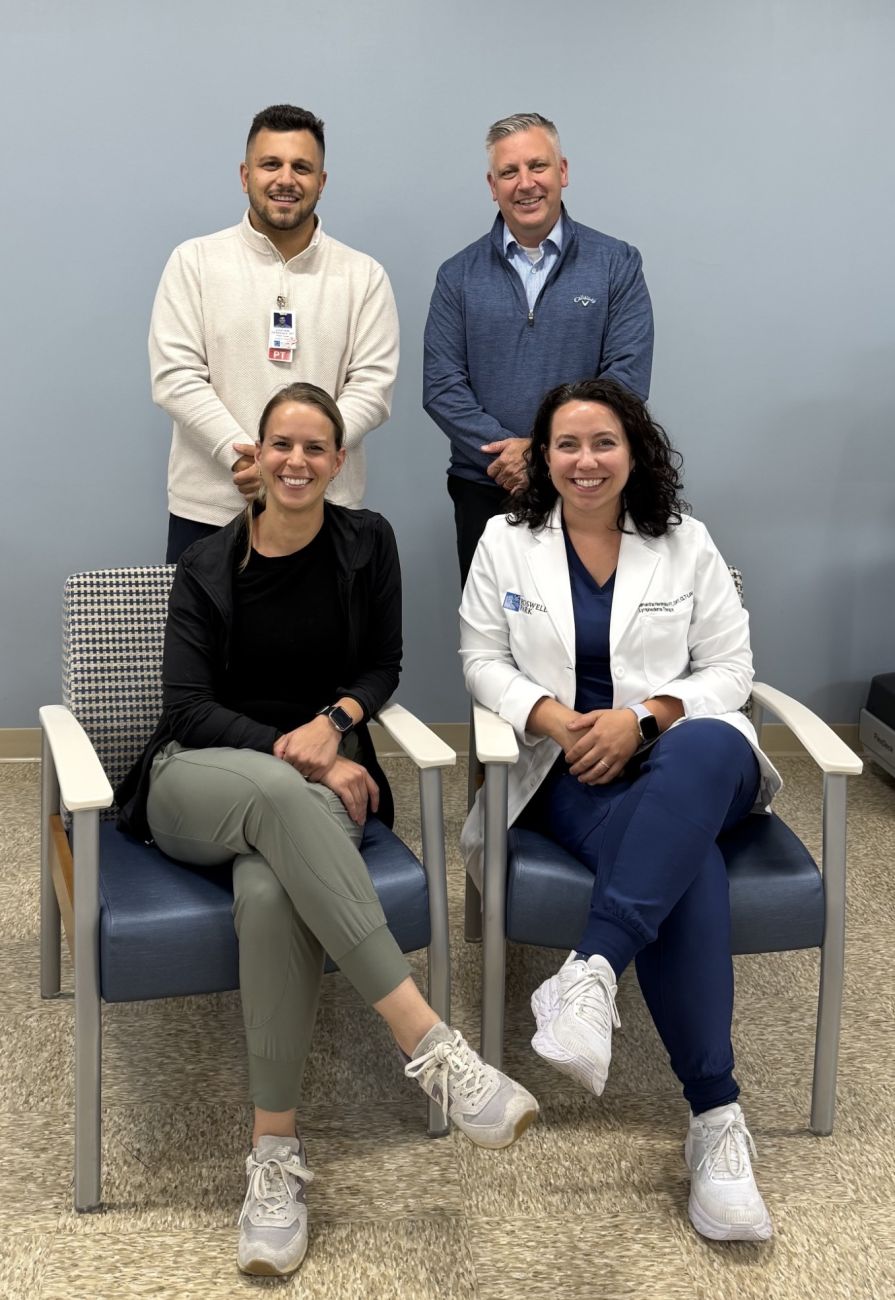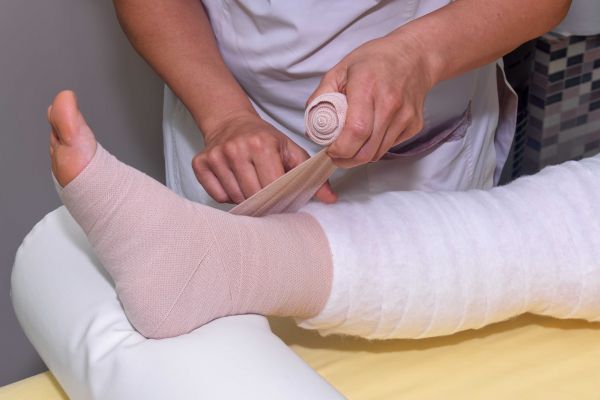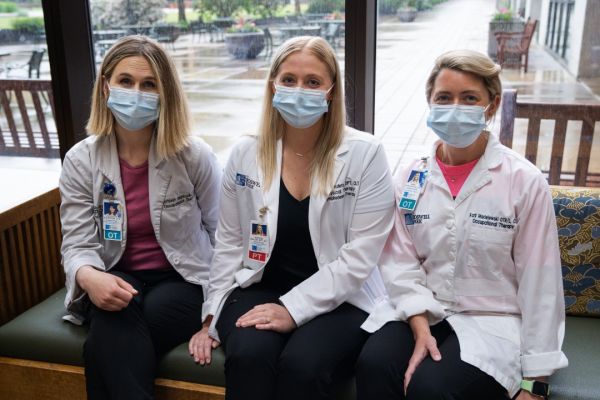Take a moment to think about how long it takes to walk from one area of your home to another, both in terms of distance and time. It’s such a relatively easy task that it’s almost done without thinking.
For some cancer patients, the effects of surgery or chemotherapy and radiation treatment may significantly limit their ability to simply move about their homes. That’s where the dedicated physical therapy specialistsat Roswell Park Comprehensive Cancer Center come in and help patients regain strength, mobility, independence and other goals.
Physical therapists, available at both the main hospital and 100 College Parkway location in Amherst, are important people in a patient’s cancer rehabilitation. At Roswell Park, we offer inpatient and outpatient services, including physical therapy, lymphedema management, pelvic floor rehabilitation and pulmonary rehabilitation services.
Much like occupational therapists, physical therapists are dedicated to helping patients regain strength and mobility so they can care for themselves and return home safely. Physical therapists look more at strength and endurance to complete tasks, like walking down the hallway from one room to another and having the stamina to do something a little more taxing, like grocery shopping. They also work with the patient’s family and caregivers to ensure their safety and comfort once released from the hospital.
“A lot of it is education. People don’t necessarily know what to expect,” says Melissa Herrmann, BS. “With a knee replacement, I feel like they’re very well prepared for what you’re going to go through. With cancer treatment, no one really prepares you for that and the hiccups that can happen along the way."
It’s also important to be empathetic toward the patients in a way that differs from other departments, as physical therapists might have a better understanding of the concerns the patient has about their progress and treatment and the physical limitations they might be feeling.
Understanding the complexities of mobility and cancer
While there are physical therapy practices available in the community, the therapists at Roswell Park are specialists in working with cancer patients, understanding the types of cancer treated at the center, the side effects of those treatments and how a person’s body is affected by it. “When you talk about an individual treated here, they’re being treated by a physical therapist familiar with all those considerations. We have both inpatient and outpatient physical therapy here and, being aware of the types of cancer treated here, we understand which results matter,” says Carolyn Miller, DPT. That includes certain test results that could impact therapy, including hemoglobin and platelet counts, whether a person has any existing fractures or sensitivities or are at higher risk of falling.
Physical therapists are in close communication with a patient’s doctors to know which types of treatments and exercises will be most helpful, before, during and after chemotherapy, radiation and surgery. If a patient just had a mastectomy, for example, and needs to be able to raise their arm for radiation treatment after the surgery, their physical therapist will work with them to make sure those movements are possible.
Why is rehabilitation important?
Surgery, chemotherapy, radiation, transplant and other cancer treatments can cause many side effects. More than 80% of cancer patients have side effects that can be improved with rehabilitation. You don’t have to wait to complete your cancer treatment before seeking relief.
The patient’s health at the time of their diagnosis and treatment also makes a difference in their mobility goals: “We need to figure out how to return to functional mobility after surgery. If a patient is on the medical floor, we need to know the background of where they are in their treatment, if they’ve just been diagnosed or if they have been in treatment for a while and are trying to maintain mobility. Do we need to help them maintain the strength they had when they came in, or did they come in with some debilitation and we need to help build them back up?” says therapist Michele Kujawa, DPT.
“Working with patients is not always easy, as we need to accommodate other medical conditions or health-related issues, such as cardiovascular disease, lung disease, diabetes, stroke, chronic back pain and/or previous injuries, etc., all of which make it more challenging and more rewarding,” adds Andrew Ray, PhD, PT.
Addressing specific side effects
Roswell Park also provides specialized treatment for lymphedema management and pelvic health care.
Lymphedema is a chronic condition that causes swelling, typically in the arms or legs, due to a buildup of lymphatic fluid in the soft tissues. The swelling occurs because the lymphatic system, which is part of the immune system and works to drain excess fluid from tissues, is either damaged or not functioning properly. Lymphedema is a side effect that can occur as a result of cancer treatments, especially surgery and radiation therapy. “Our goal as a lymphedema department is to manage swelling, whether it be in the limbs, trunk, breast or trunk to allow patients to feel comfortable in their own skin, reduce risk of infection, and remain safe and independent,” says Natalie Kaleta, PT, DPT, CLT.
Dysfunction in the pelvic floor can lead to urinary incontinence, pain, bowel incontinence and sexual health dysfunction, says Renée Genereaux, PT, DPT, PRPC. “The patient’s goal is usually to stop leaking urine or control their bowel movements, or to improve pain within the pelvis, whether that be vaginal pain or rectal pain. As a physical therapist, my goal is always to find ways for the patient to manage their symptoms themselves.” She works with patients on manually releasing tight muscles, educating them on normal urine, bowel and sexual functionality of their pelvic muscles and will share with them techniques to manage symptoms, including therapeutic exercises to improve range of motion, strength and coordination of pelvic floor muscles.
A personalized timeline for recovery
As for how long it might take to get a patient back on their feet, steady and ready to return home, that answer will depend on each individual patient, their needs, their goals and their progress. Some patients might need a single session with a therapist to learn a new technique; others, including those who receive transplant services, might need months of work, with appointments several times a week, for their recovery and therapy to progress.
Sometimes that includes a little tough love. “No one wants to be in a hospital. People aren’t here because they feel good. Part of our job is to encourage the patient to get up and move around and remind them of why it’s important to get up and move around,” says Tricia Atencio, DPT. “Sometimes we’re the ones who can say, ‘Ok, let’s walk outside today, let’s go to the park,’ and they’ll be open to it.”
The need for a little firmness with their compassion and empathy helps physical therapists keep their patients on track to achieve their goals, no matter the size.
Support services for patients
Learn more about the various support services offered to patients and their families at Roswell Park.




